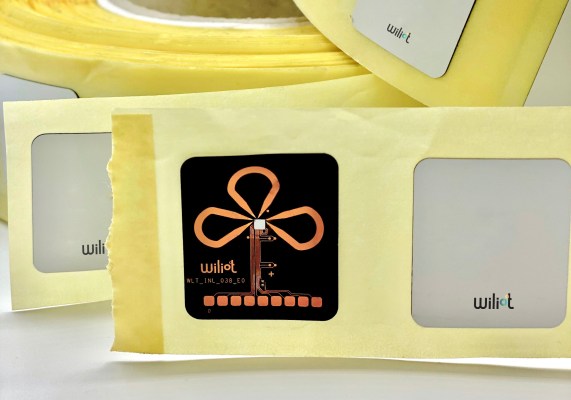Wiliot — the IoT startup that has developed a new kind of processor that is ultra thin and light and runs on ambient power but possesses all the power of a “computer” — has picked up a huge round of growth funding on the back of strong interest in its technology, and a strategy aimed squarely at scale.
The company has raised $200 million, a Series C that it will use toward its next steps as a business. In the coming months, it will make a move into a SaaS model — which Wiliot likes to say refers not to “software as a service,” but “sensing as a service,” using its AI to read and translate different signals on the object attached to the chip — to run and sell its software. This will be combined with a shift to a licensing model for its chip hardware, so that they can be produced by multiple third parties. Wiliot says that it already has several agreements in place for the chip licensing part. The plan is for this, in turn, to lead to a new range of sizes and form factors for the chips down the line.
Softbank’s Vision Fund 2 led the financing, with previous backers — it’s a pretty illustrious list that speaks of the opportunities ahead — including 83North, Amazon Web Services, Inc. (AWS), Avery Dennison, Grove Ventures, M Ventures, the corporate VC of Merck KGaA, Maersk Growth, Norwest Venture Partners, NTT DOCOMO Ventures, Qualcomm Ventures LLC, Samsung Venture Investment Corp., Vintage Investment Partners and Verizon Ventures.
Wiliot’s valuation is not being disclosed but Steve Statler, the startup’s SVP, described it as “in line” with its pivot to SaaS. For some further context, when we last covered Wiliot funding, a $30 million Series B in 2019, sources told us it was valued at $120 million, although between then and now it also extended that Series B to $70 million, implying a pre-money valuation of closer to $200 million. With basic math, that implies a valuation of more like $400 million now, although the SaaS focus, and strong interest already in licensing the tech, means it could easily be more. (I’ll update as and when I learn more.)
Up to now, the company has been focusing on business development based on “version 1” of its chips, produced by Wiliot itself. (Version 2, which is likely to be announced officially in September, will be the chips that third parties will make.) Wiliot’s chips are, in the words of Statler, printable computers the size and thinness of postage stamps that contain RAM, ROM, sensors, Bluetooth, an ARM CPU, memory and secure communications capabilities, all running on ambient power (radio waves) already in the air. Thin like RFID tags, these are significantly more powerful and useful.
Statler said Wiliot has 30 paying customers so far using “hundreds of thousands” of these chips. But the scale (and opportunity) of IoT is such that even in the hundreds of thousands bracket, none of these are full deployments but limited tests.
Statler told me that one such customer is a major pharmaceutical company (name not disclosed) that’s making vaccines: it’s attaching the chips to a proportion of its vaccine vials to monitor temperature, dosage amounts (since you get several doses out of one vial) and dilution, with the plan being to use the system across all of its vaccines in the future, something that has particular relevance right now, given how strongly vaccines are figuring in the fight against the COVID-19 health pandemic globally.
Other industries that have been talking with Wiliot include consumer packaged goods companies, furniture companies and the apparel industry (which has been a big adopter of RFID).
With version 2, the ambient power aspect will also expand. In version 1, the chips can harness energy from radio waves that are already in the air, as well as via inexpensive devices that provide a boost of power to spread the waves around more evenly. Right now the range of those boosters in 1-3 meters, Statler said, but version 2 will be a “major breakthrough” that will see that extended, making the booster a more interesting option. Wiliot also, notably, has been working with Sigfox, which is also developing some very innovative ways of harnessing and using ambient power, so maybe we should watch this space.
“This is just the tip of the iceberg,” CEO and co-founder Tal Tamir told me back in 2019 (he wasn’t available for an interview this time around, unfortunately). “We think many edge devices will come that will harvest radio frequency energy. But the problem is not what you harvest but how much you need. If you get nanowatts of energy and a phone consumes 3-5 watts when active, you can see where this has to go.”
For a company like SoftBank that is making multiple bets around services and hardware across its investment and ownership portfolios, there is a lot of opportunity here not just as a financial backer but strategic partner, too.
“By inventing the first hyperscalable, self-powered computer that uses AI to sense the world, Wiliot is positioned to bring together the digital and physical” said Yanni Pipilis, managing partner at SoftBank Investment Advisers, in a statement. “We have always believed that with IoT and AI, people will live better and healthier lives — where any food or medicine has the ability to understand if it’s safe to use and communicate seamlessly with people. We are pleased to play a part in helping Wiliot dramatically scale the ever-expanding application of IoT globally.”
